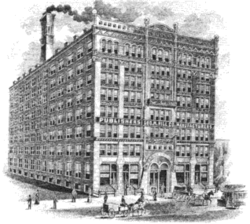
Lyman Frank Baum was an American author best known for his children's fantasy books, particularly The Wonderful Wizard of Oz, part of a series. In addition to the 14 Oz books, Baum penned 41 other novels, 83 short stories, over 200 poems, and at least 42 scripts. He made numerous attempts to bring his works to the stage and screen; the 1939 adaptation of the first Oz book became a landmark of 20th-century cinema.

The Wonderful Wizard of Oz is a 1900 children's novel written by author L. Frank Baum and illustrated by W. W. Denslow. It is the first novel in the Oz series of books. A Kansas farm girl named Dorothy ends up in the magical Land of Oz after she and her pet dog Toto are swept away from their home by a cyclone. Upon her arrival in the magical world of Oz, she learns she cannot return home until she has destroyed the Wicked Witch of the West.

John Rea Neill was a magazine and children's book illustrator primarily known for illustrating more than forty stories set in the Land of Oz, including L. Frank Baum's, Ruth Plumly Thompson's, and three of his own. His pen-and-ink drawings have become identified almost exclusively with the Oz series. He did a great deal of magazine and newspaper illustration work which is not as well known today.

William Wallace Denslow was an American illustrator and caricaturist remembered for his work in collaboration with author L. Frank Baum, especially his illustrations of The Wonderful Wizard of Oz. Denslow was an editorial cartoonist with a strong interest in politics, which has fueled political interpretations of The Wonderful Wizard of Oz.
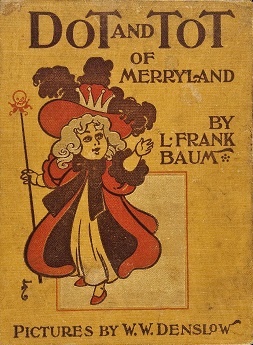
Dot and Tot of Merryland is a 1901 novel by L. Frank Baum. After Baum wrote The Wonderful Wizard of Oz, he wrote this story about the adventures of a little girl named Dot and a little boy named Tot in a land reached by floating on a river that flowed through a tunnel. The land was called Merryland and was split into seven valleys. The book was illustrated by artist W. W. Denslow, who had illustrated three previous Baum books.

Political interpretations of The Wonderful Wizard of Oz include treatments of the modern fairy tale as an allegory or metaphor for the political, economic, and social events of America in the 1890s. Scholars have examined four quite different versions of Oz: the novel of 1900, the Broadway play of 1902, the Hollywood film of 1939, and the numerous follow-up Oz novels written after 1900 by Baum and others.
Michael Patrick Hearn is an American literary scholar as well as a man of letters specializing in children's literature and its illustration. His works include The Annotated Wizard of Oz (1973/2000), The Annotated Christmas Carol (1977/2003), and The Annotated Huckleberry Finn (2001). He considers the three most quintessential American novels to be Moby-Dick by Herman Melville, The Wonderful Wizard of Oz by L. Frank Baum, and The Adventures of Huckleberry Finn by Mark Twain.
The International Wizard of Oz Club, Inc., was founded during 1957 by Justin G. Schiller, a then thirteen-year-old boy. The sixteen charter members, some of whom continue to make valuable contributions to the club, were garnered from the mailing list found among the papers of the recently deceased Jack Snow, with whom Schiller and the others had discussed the work of L. Frank Baum.
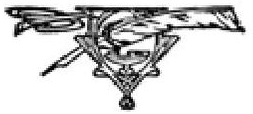
The Reilly and Britton Company, known after 1918 as Reilly & Lee, was an American publishing company of the early and middle 20th century, best known for children's and popular culture books from authors like L. Frank Baum and Edgar A. Guest. Founded in 1904 by two former employees of George M. Hill's publishing company, Frank Kennicott Reilly and Charles Britton, the company would later be guided by William F. Lee until it was acquired by the Henry Regnery Company in 1959.

American Fairy Tales is the title of a collection of twelve fantasy stories by L. Frank Baum, published in 1901 by the George M. Hill Company, the firm that issued The Wonderful Wizard of Oz the previous year. The cover, title page, and page borders were designed by Ralph Fletcher Seymour; each story was furnished with two full-page black-and-white illustrations, by either Harry Kennedy, Ike Morgan, or Norman P. Hall.
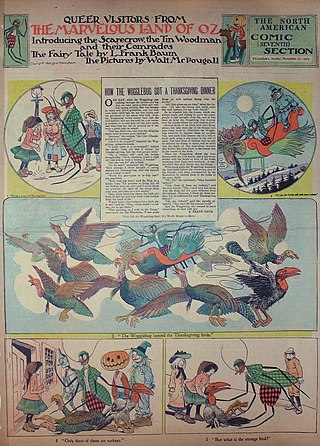
Queer Visitors from the Marvelous Land of Oz was a newspaper comic strip written by L. Frank Baum and illustrated by Walt McDougall, a political cartoonist for the Philadelphia North American. Queer Visitors appeared in the North American, the Chicago Record-Herald and other newspapers from 28 August 1904 to 26 February 1905. The series chronicles the misadventures of the Scarecrow, the Tin Woodman, the Woggle-Bug, Jack Pumpkinhead, and the Sawhorse, as the Gump flies them to various cities in the United States. The comic strip in turn produced its own derivation, The Woggle-Bug Book (1905).

Father Goose: His Book is a collection of nonsense poetry for children, written by L. Frank Baum and illustrated by W. W. Denslow, and first published in 1899. Though generally neglected a century later, the book was a groundbreaking sensation in its own era; "once America's best-selling children's book and L. Frank Baum's first success," Father Goose laid a foundation for the writing career that soon led to The Wonderful Wizard of Oz and all of Baum's later work.
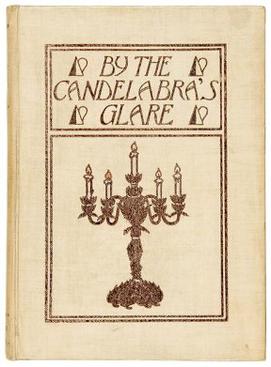
By the Candelabra's Glare is a 1898 collection of poems written by L. Frank Baum. One of his earliest works, the book was significant in Baum's evolution from amateur to professional author.
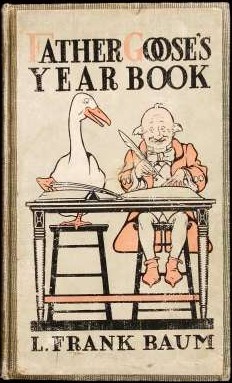
Father Goose's Year Book: Quaint Quacks and Feathered Shafts for Mature Children is a collection of humorous nonsense poetry written by L. Frank Baum, author of the Oz books. It was published in 1907.

L. Frank Baum's Juvenile Speaker: Readings and Recitations in Prose and Verse, Humorous and Otherwise is an anthology of literary works by L. Frank Baum, author of the Oz books. The book was first published in 1910, with illustrations by veteran Baum artists John R. Neill and Maginel Wright Enright; a subsequent 1912 edition was retitled Baum's Own Book for Children. The book constitutes a complex element in the Baum bibliography.
Paul Tietjens was an American composer of the early twentieth century. He is best known for composing music for The Wizard of Oz, the 1902 stage adaptation of L. Frank Baum's The Wonderful Wizard of Oz, one of the great popular hits of its era.

Maud Gage Baum was the wife of American children's publisher L. Frank Baum. Her mother was the suffragist Matilda Joslyn Gage. In her early life, she attended a boys' high school.
The plays of L. Frank Baum are an important aspect of Baum's writing career about which very little is known. While even most brief biographies, long before the Internet, have noted Baum's work as a playwright, these works have been rarely performed beyond his lifetime, and almost none have been published aside from two scenarios and a first act of three unfinished works in The Musical Fantasies of L. Frank Baum, compiled with an introduction by Alla T. Ford. Aside from his youthful success with The Maid of Arran, his blockbuster eight-year run with The Wizard of Oz, his failure with The Woggle-Bug, and The Tik-Tok Man of Oz as source material for his novel, Tik-Tok of Oz, very little is known about his dramatic output, and mostly from the publications of Michael Patrick Hearn, Susan Ferrara, and Katharine M. Rogers. Hearn identifies 41 different titles in the bibliography of the 2000 edition of The Annotated Wizard of Oz, plus one play without a title, although some of these titles clearly refer to drafts of the same play, such as the early titles of The Tik-Tok Man of Oz.
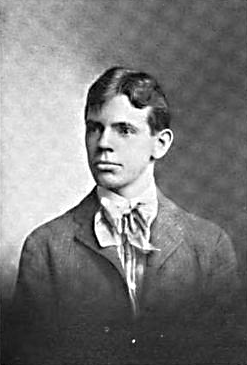
Isaac Morgan was a well-known newspaper illustrator for several big newspapers in Chicago and New York.
This is a complete bibliography for American children's writer L. Frank Baum.
